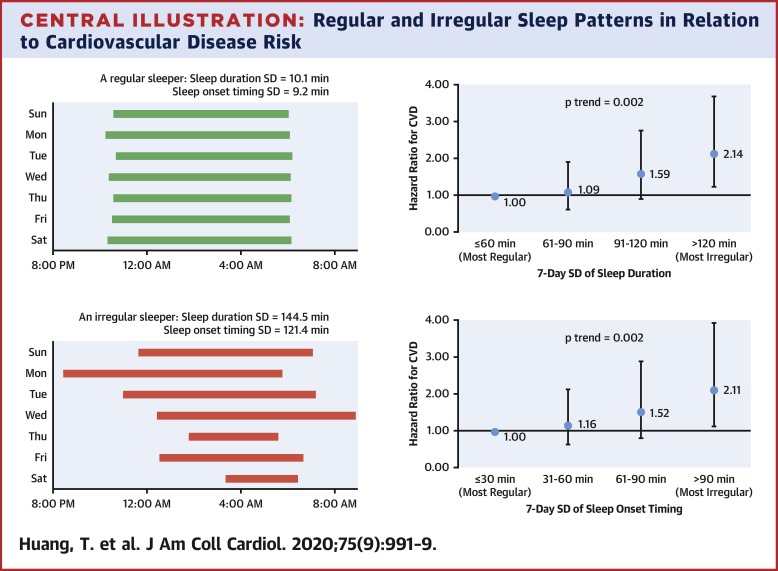当前位置:
X-MOL 学术
›
J. Am. Coll. Cardiol.
›
论文详情
Our official English website, www.x-mol.net, welcomes your
feedback! (Note: you will need to create a separate account there.)
Sleep Irregularity and Risk of Cardiovascular Events
Journal of the American College of Cardiology ( IF 21.7 ) Pub Date : 2020-03-01 , DOI: 10.1016/j.jacc.2019.12.054 Tianyi Huang 1 , Sara Mariani 2 , Susan Redline 2
Journal of the American College of Cardiology ( IF 21.7 ) Pub Date : 2020-03-01 , DOI: 10.1016/j.jacc.2019.12.054 Tianyi Huang 1 , Sara Mariani 2 , Susan Redline 2
Affiliation

|
BACKGROUND
The cardiovascular system exhibits strong circadian rhythms to maintain normal functioning. Irregular sleep schedules, characterized by high day-to-day variability in sleep duration or timing, represent possibly milder but much more common and chronic disruption of circadian rhythms in the general population than shift work. OBJECTIVES
This study aimed to prospectively examine the association between sleep regularity and risk of cardiovascular disease (CVD). METHODS
In MESA (Multi-Ethnic Study of Atherosclerosis), 1,992 participants free of CVD completed 7-day wrist actigraphy for sleep assessment from 2010 to 2013 and were prospectively followed through 2016. The study assessed sleep regularity using the SD of actigraphy-measured sleep duration and sleep-onset timing across 7 days. Incident CVD included nonfatal and fatal cardiovascular events. A Cox proportional hazards model was used to estimate hazard ratios (HRs) for incident CVD according to SD of sleep duration and timing, adjusted for traditional CVD risk factors (including CVD biomarkers) and other sleep-related factors (including average sleep duration). RESULTS
During a median follow-up of 4.9 years, 111 participants developed CVD events. The multivariable-adjusted HRs (95% confidence intervals) for CVD across categories of sleep duration SD were 1.00 (reference) for ≤60 min, 1.09 (0.62 to 1.92) for 61 to 90 min, 1.59 (0.91 to 2.76) for 91 to 120 min, and 2.14 (1.24 to 3.68) for >120 min (p trend = 0.002). Similarly, compared with participants with a sleep timing SD ≤30 min, the HRs (95% confidence intervals) for CVD were 1.16 (0.64 to 2.13) for 31 to 60 min, 1.52 (0.81 to 2.88) for 61 to 90 min, and 2.11 (1.13 to 3.91) for >90 min (p trend = 0.002). Exclusion of current shift workers yielded similar results. CONCLUSIONS
Irregular sleep duration and timing may be novel risk factors for CVD, independent of traditional CVD risk factors and sleep quantity and/or quality.
中文翻译:

睡眠不规律和心血管事件的风险
背景心血管系统表现出强烈的昼夜节律以维持正常功能。不规律的睡眠时间表,其特征是睡眠持续时间或时间的日常变化很大,与轮班工作相比,普通人群的昼夜节律可能更温和但更常见和慢性破坏。目的 本研究旨在前瞻性地检验睡眠规律与心血管疾病 (CVD) 风险之间的关联。方法 在 MESA(动脉粥样硬化多种族研究)中,1,992 名无 CVD 的参与者完成了 2010 年至 2013 年为期 7 天的腕部活动图进行睡眠评估,并前瞻性地随访至 2016 年。该研究使用活动记录测量睡眠的 SD 评估睡眠规律7 天的持续时间和睡眠开始时间。事件 CVD 包括非致命性和致命性心血管事件。Cox 比例风险模型用于根据睡眠持续时间和时间的 SD 估计心血管事件的风险比 (HR),并针对传统 CVD 风险因素(包括 CVD 生物标志物)和其他睡眠相关因素(包括平均睡眠持续时间)进行调整。结果 在 4.9 年的中位随访期间,111 名参与者发生了 CVD 事件。跨睡眠持续时间 SD 类别的 CVD 的多变量调整 HR(95% 置信区间)为 1.00(参考)≤60 分钟,1.09(0.62 至 1.92)61 至 90 分钟,1.59(0.91 至 2.76)91 至120 分钟,2.14(1.24 到 3.68)>120 分钟(p 趋势 = 0.002)。同样,与睡眠时间 SD ≤ 30 分钟的参与者相比,CVD 的 HR(95% 置信区间)为 1.16(0.64 至 2.13),持续 31 至 60 分钟,1。52(0.81 至 2.88)持续 61 至 90 分钟,2.11(1.13 至 3.91)持续 >90 分钟(p 趋势 = 0.002)。排除当前轮班工人产生了类似的结果。结论 不规则的睡眠持续时间和时间可能是 CVD 的新危险因素,独立于传统的 CVD 危险因素和睡眠数量和/或质量。
更新日期:2020-03-01
中文翻译:

睡眠不规律和心血管事件的风险
背景心血管系统表现出强烈的昼夜节律以维持正常功能。不规律的睡眠时间表,其特征是睡眠持续时间或时间的日常变化很大,与轮班工作相比,普通人群的昼夜节律可能更温和但更常见和慢性破坏。目的 本研究旨在前瞻性地检验睡眠规律与心血管疾病 (CVD) 风险之间的关联。方法 在 MESA(动脉粥样硬化多种族研究)中,1,992 名无 CVD 的参与者完成了 2010 年至 2013 年为期 7 天的腕部活动图进行睡眠评估,并前瞻性地随访至 2016 年。该研究使用活动记录测量睡眠的 SD 评估睡眠规律7 天的持续时间和睡眠开始时间。事件 CVD 包括非致命性和致命性心血管事件。Cox 比例风险模型用于根据睡眠持续时间和时间的 SD 估计心血管事件的风险比 (HR),并针对传统 CVD 风险因素(包括 CVD 生物标志物)和其他睡眠相关因素(包括平均睡眠持续时间)进行调整。结果 在 4.9 年的中位随访期间,111 名参与者发生了 CVD 事件。跨睡眠持续时间 SD 类别的 CVD 的多变量调整 HR(95% 置信区间)为 1.00(参考)≤60 分钟,1.09(0.62 至 1.92)61 至 90 分钟,1.59(0.91 至 2.76)91 至120 分钟,2.14(1.24 到 3.68)>120 分钟(p 趋势 = 0.002)。同样,与睡眠时间 SD ≤ 30 分钟的参与者相比,CVD 的 HR(95% 置信区间)为 1.16(0.64 至 2.13),持续 31 至 60 分钟,1。52(0.81 至 2.88)持续 61 至 90 分钟,2.11(1.13 至 3.91)持续 >90 分钟(p 趋势 = 0.002)。排除当前轮班工人产生了类似的结果。结论 不规则的睡眠持续时间和时间可能是 CVD 的新危险因素,独立于传统的 CVD 危险因素和睡眠数量和/或质量。











































 京公网安备 11010802027423号
京公网安备 11010802027423号